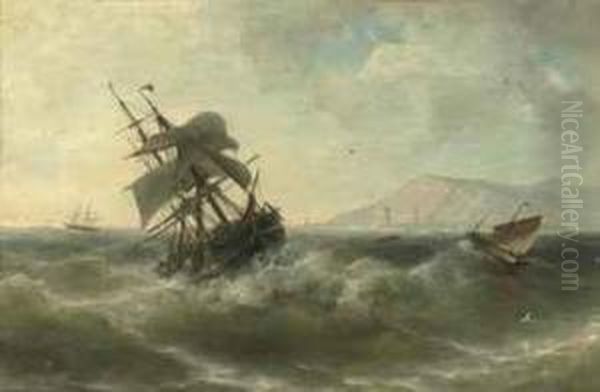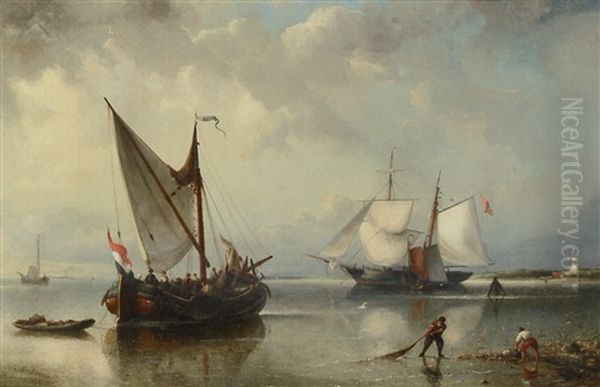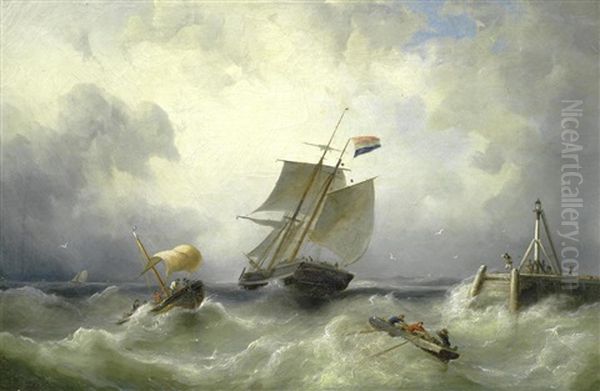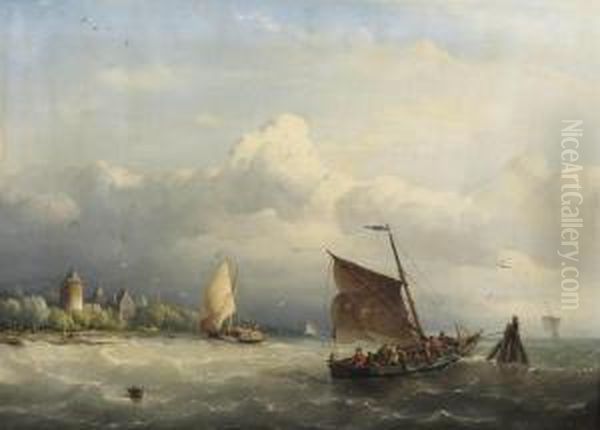Nicolaas Riegen (1827-1889) stands as a notable figure within the rich tradition of Dutch marine painting. Born in the bustling maritime city of Amsterdam in 1827, Riegen dedicated his artistic career to capturing the multifaceted relationship between the Netherlands and the sea that surrounds it. His life spanned a period of significant artistic evolution in Europe, yet he remained focused primarily on marine and landscape subjects, developing a distinct voice within the Dutch art scene of the 19th century. He passed away in 1889, leaving behind a body of work appreciated for its technical skill and evocative portrayal of nautical life.
The Maritime Focus
Riegen's oeuvre is dominated by depictions of the sea and the vessels that navigated its waters. He was particularly drawn to the dynamic and often dramatic interplay between nature's power and human endeavor. His canvases frequently feature ships battling turbulent waves, fishing boats setting out or returning to harbor, and coastal scenes under varying atmospheric conditions. This focus places him firmly in the lineage of Dutch marine artists, a tradition stretching back to the Golden Age with masters like Willem van de Velde the Younger, but Riegen brought his own 19th-century sensibilities to the genre.
His work often explores the raw energy of the sea. He possessed a keen ability to render the movement of water, from choppy surfaces reflecting grey skies to the dramatic crash of waves against rocky shores or ship hulls. This focus on the sea's moods suggests an artist deeply observant of the natural world and its inherent power, a common theme in marine art but one Riegen approached with consistent dedication.
Artistic Style and Technique

Stylistically, Nicolaas Riegen's work exhibits characteristics associated with the broader movements of Realism and Dutch Impressionism, particularly the Hague School, although direct affiliation isn't explicitly documented. His paintings demonstrate a commitment to depicting scenes with a degree of accuracy, paying close attention to the structure of ships, the play of light on water, and the atmospheric effects of weather. The influence of Impressionistic tendencies can be seen in his handling of light and brushwork, aiming to capture the fleeting moments and specific conditions of a scene.
He worked primarily in oil on canvas, employing skillful techniques to achieve the desired textures and effects. His rendering of skies, water, and the weathered surfaces of boats showcases a proficient command of the medium. While not radically experimental, his style was effective in conveying the specific ambiance of the Dutch coastal environment – often characterized by its unique light and expansive horizons. His perspective and skill in depicting the sea and ships were considered distinctive by observers.
Representative Works
Several specific works help illustrate Nicolaas Riegen's artistic output and thematic concerns. Among his known paintings is Woelig Water (Turbulent Water), dated 1869. The title itself points to his interest in depicting the sea in its more agitated states, likely showcasing vessels navigating challenging conditions. This theme is echoed in A three-master on choppy waters, a work measuring 55 x 85 cm and bearing the signature "N. Riegen." This painting vividly captures the struggle of a large sailing ship against a restless sea, highlighting the drama inherent in maritime life during the age of sail.
Another significant piece is Hauling in the catch, dated 1871 (65.1 x 98.4 cm). This work shifts the focus slightly towards the human element of marine life – the labor of fishermen. It likely depicts the demanding process of bringing nets aboard, a common scene along the Dutch coasts and one that allowed artists to explore themes of work, community, and dependence on the sea. Similarly, Fishing Boats off a Jetty, the Muiderslot in the Distance (53.6 x 81.8 cm) combines marine activity with a specific geographical landmark, grounding the scene in a recognizable Dutch location and adding a picturesque landscape element.
The dangers of seafaring are directly addressed in Shipwreck near a rocky coast, dated 1870 (44.4 x 67.9 cm). Shipwreck scenes were a popular subgenre within marine painting, allowing artists to explore themes of tragedy, survival, and the overwhelming power of nature. Riegen’s interpretation likely emphasized the dramatic confrontation between the fragile vessel and the unforgiving coastline. Another work, known from auction records as Farewell at Dawn , measuring 33.6 x 49 cm, suggests a more poignant, perhaps narrative scene involving departure or separation within a maritime context.

Interestingly, Riegen did not exclusively paint marine subjects. A work titled Poverty and Charity, later known as A Rich Lady Visits a Poor Family, was exhibited in 1853 and subsequently purchased. This indicates an engagement with social genre themes prevalent in the 19th century, depicting interactions between different social classes. While marine painting remained his primary focus, this work shows a broader artistic interest.
The Artistic Landscape of 19th Century Netherlands
Nicolaas Riegen worked during a vibrant period in Dutch art. The 19th century saw a resurgence of interest in distinctly Dutch themes, particularly landscapes and marine scenes, moving away from the neoclassical and historical subjects that had dominated earlier periods. Riegen was a contemporary of the artists associated with the Hague School, a movement that flourished roughly between 1860 and 1890. Artists like Hendrik Willem Mesdag, famous for his Panorama Mesdag and numerous seascapes, shared Riegen's dedication to marine subjects, capturing the North Sea coast with atmospheric realism.
Other prominent Hague School figures included Jacob Maris and Willem Maris, known for their evocative landscapes, often featuring water, canals, and coastal views under dramatic Dutch skies. Anton Mauve, another key member, depicted rural landscapes, sometimes including coastal dunes or scenes near water. While Riegen's direct interaction with these specific artists isn't documented in the available sources, his work shares the Hague School's emphasis on realistic depiction, tonal harmony, and capturing the specific light and atmosphere of the Netherlands.
The broader context of 19th-century Dutch marine painting saw a diversification of themes compared to earlier periods. While grand depictions of naval battles declined, artists focused more on everyday maritime life: fishing communities, coastal shipping, atmospheric studies of the sea and sky. Artists like Johannes Christiaan Schotel had already revitalized marine painting earlier in the century. Contemporaries closer to Riegen's time included Louis Meijer, known for his dramatic seascapes, and Abraham Hulk Snr, an Anglo-Dutch painter specializing in coastal and river scenes. The landscape painter Andreas Schelfhout, though primarily known for his winter scenes, also depicted coastal areas.

Furthermore, Dutch artists were increasingly aware of international trends, particularly French Realism (Gustave Courbet) and Impressionism (Claude Monet, Alfred Sisley). Johan Barthold Jongkind, a Dutch precursor to Impressionism who worked extensively in France, painted numerous scenes of the Dutch coast, bridging Dutch traditions and French innovations. While the provided information doesn't specify Riegen's international connections or influences, the artistic environment was one of exchange and evolving styles. Painters like Marten Waayers and the Belgian-born Charles-Louis Verbaekhoven, who also depicted marine subjects, were part of this wider milieu.
Training, Influence, and Personal Life
Despite the details available about his works and general context, specific information regarding Nicolaas Riegen's artistic training remains elusive based on the consulted sources. There is no mention of his teachers or mentors who might have guided his early development. Similarly, there is no record of him having formally taught students or apprentices, which was a common practice for established artists. His skills appear to have been developed through practice and observation within the artistic environment of Amsterdam and the Netherlands.
The question of artistic influence is also difficult to pinpoint with certainty. While his style aligns with broader trends like Realism and Dutch Impressionism, the sources do not confirm specific artists who directly influenced Riegen, nor do they indicate artists who were demonstrably influenced by him. He appears to have been a competent practitioner working within established genres, contributing his own interpretations of marine and landscape themes, rather than a radical innovator who significantly altered the course of Dutch art. His relationship with contemporaries seems to have been parallel rather than deeply interconnected in terms of documented influence.
Information about Riegen's personal life is similarly scarce. Beyond his birth and death dates and his professional identity as a painter in Amsterdam, few biographical details or anecdotes are recorded in the available materials. No significant personal events, travels, or relationships are highlighted. The only specific dated event mentioned relates to his professional life: the exhibition and sale of his painting Poverty and Charity in 1853. This lack of personal detail is not uncommon for artists of his era who did not achieve the very highest levels of fame or notoriety, leaving the focus primarily on their artistic output.
Market Presence and Legacy

Nicolaas Riegen's works have maintained a presence in the art market, appearing at auctions conducted by prominent houses such as Sotheby's and Christie's. This indicates a continued, albeit perhaps modest, level of collector interest in his paintings. Auction records provide estimates for some of his works; for instance, Farewell at Dawn (33.6 x 49 cm) carried an estimate of €1500 to €3500, while Shipwreck near a rocky coast (44.4 x 67.9 cm) was estimated between €700 and €900. These figures suggest his work is accessible to collectors of 19th-century European art but does not command the prices of the leading masters of the period.
His painting A three-master on choppy waters was noted as being handled by Annemijn van Grimbergen, likely an expert or representative associated with an auction house, further confirming the circulation of his work in the commercial sphere. The consistent appearance of his marine scenes at auction underscores his recognized specialization in this genre.
In summary, Nicolaas Riegen was a dedicated and skilled Dutch painter of the 19th century who specialized in marine and landscape art. Born and working primarily out of Amsterdam, he contributed to the enduring Dutch tradition of depicting the sea, focusing on its dynamic nature, the vessels that sailed it, and the coastal environment. While perhaps not a major innovator, his work reflects the realistic and atmospheric concerns of his time, aligning with aspects of the Hague School. Lacking detailed biographical information or documented connections to specific teachers or students, his legacy rests on his evocative paintings, which continue to be appreciated for their faithful and often dramatic portrayal of the Netherlands' relationship with the sea. He holds a place within the narrative of 19th-century Dutch art as a consistent chronicler of maritime life.